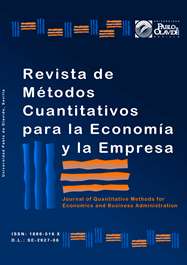The Risk Recharged Premium for a Survival Life Insurance: Recharged Premium through the Use of a Coherent Risk Measure
DOI:
https://doi.org/10.46661/revmetodoscuanteconempresa.2227Keywords:
Seguro de rentas, recargo, medida de riesgo coherente, función de distorsión, survival life insurance (annuities), surcharge, coherent risk measure, distortion functionAbstract
The goal of this study is to get a premium calculation principle, for the life insurance business, based on a coherent risk measure (Wang, 1995) in the form of power, called "Proportional Hazards (PH) Transforms" to justify the recommendation of Solvency II to reduce the effect of the mortality instantaneous rate and thus get an implicitly surcharged premium to deal deviations of actual claims regarding expected. Survival life insurance has been selected for this research, and the premium risk has been calculated for the four accepted laws of survival, such as the first and second Dormoy, Gomperzt law, and Makeham law. The selection of these laws has been taken because they best fit the model based on the numerical values assigned to the parameters by using mortality tables developed by Pérez (2000), Projected Table 2000 Spanish Mortality from 1950-1990. In the life insurance, coverage claims survival negative experience for the company means that the insured survive longer than expected (live longer). Thus, when calculating premiums, it is common practice to add a safety margin implied, as a percentage, the odds of death qx, or use a mortality table whose chances of passing are lower than those of the human being taken into account. This can be interpreted as a decrease of the mortality instantaneous rate.Downloads
References
Artzner, P. (1999) “Application of coherent risk measures to capital requirements in insurance”, North American Actuarial Journal, 3 (2), pp.11–15.
Aartzner, P.; Delbaen, F.; Eber, J.M.; Heath, D. (1999) “Coherent measures of risk”, Mathematical Finance, 9, pp. 203–228.
Bowers, J.R.; Newton, L.; Gerber, H.; Jones, D. (1997) Actuarial Mathematics, The Society of Actuaries, Illinois.
Denuit, D.; Dhaene, J.; Goovaerts, M.; Kaas, R. (2005) Actuarial Theory for Dependent risks: measures, orders and model, John Wiley & Sons.
European Commission (2010) Internal Market and Services DG. Insurance and pensions, Brussels, QIS5 Technical Specifications (Working Document of the Commission services). Disponible en: https://www.ceiops.eu.
Gerber, H. (1979) An introduction to mathematical risk theory, Huebner Foundation.
Gómez, E.; Sarabia, J.M. (2008) Teoría de la Credibilidad. Desarrollo y aplicaciones en primas de seguros y riesgos operacionales, Fundación MAPFRE.
Heilmann, W. (1989) “Decision theoretic foundations of credibility theory”, Insurance: Mathematics & Economics, 8, pp. 77–95.
Heras, A. (2010) “Medidas del riesgo y sus aplicaciones actuariales y financieras”, Economía Española y protección social, II, pp. 69–103.
Hernández Solís, M. (2013) “Tarificación en seguros de vida con la medida de riesgo esperanza distorsionada”, Tesis Doctoral, Universidad Complutense, Madrid.
Hurlimann, W. (2008) “Distortion Risk measures and Economic capital”, North American Actuarial Journal, 8, pp. 86–95.
Landsman, Z.; Sherris, M. (2001) “Risk measures and insurance premium principles”, Insurance: Mathematics & Economics, 29, pp. 103–115.
Modigliani, M.; Miller, M. (1958) “The cost of capital, Corporate Finance and the Theory of Investment”, The American Economic Review, 48, pp. 261–297.
Prieto, E.; Fernández, J. (2000) Tablas de Mortalidad de la Población Española de 1950 a 1990, Editorial Aseguradora.
Sandell, R. (2003) El envejecimiento de la población, Real Instituto Elcano, WP 20.
Tasche, D. (2000) Risk contributions and performance measurement, Technische Universität München, Munich.
Tse, Y-K. (2009) Nonlife Actuarial Models. Theory, methods and evaluation, Cambridge University Press.
Vegas, J. (2000) “El riesgo de longevidad en los planes de pensiones”, Anales Instituto Actuarios Españoles, 6, pp. 119–157.
Wang, S. (1995) “Insurance pricing and increased limits ratemaking by proportional hazards transforms”, Insurance Mathematics and Economic, 17, pp. 43–54.
Wang, S. (1996) “Premium calculation by transforming the layer premium density”, Astin Bulletin, 26.
Wang, S. (2000) “A class of distortion operators for pricing financial and insurance risk”, Journal of Risk and Insurance, 67, pp. 15–37.
Wang, S.; Young, V.; Panjer, H. (1997) “Axiomatic characterization of insurance prices”, Insurance Mathematics and Economics, 21, pp. 173–183.
Young, V. (2004) Premium Principles, Encyclopedia of actuarial Science, Wiley, New York.
Downloads
Published
How to Cite
Issue
Section
License
Copyright (c) 2013 Revista de Métodos Cuantitativos para la Economía y la Empresa

This work is licensed under a Creative Commons Attribution-ShareAlike 4.0 International License.
Submission of manuscripts implies that the work described has not been published before (except in the form of an abstract or as part of thesis), that it is not under consideration for publication elsewhere and that, in case of acceptance, the authors agree to automatic transfer of the copyright to the Journal for its publication and dissemination. Authors retain the authors' right to use and share the article according to a personal or instutional use or scholarly sharing purposes; in addition, they retain patent, trademark and other intellectual property rights (including research data).
All the articles are published in the Journal under the Creative Commons license CC-BY-SA (Attribution-ShareAlike). It is allowed a commercial use of the work (always including the author attribution) and other derivative works, which must be released under the same license as the original work.
Up to Volume 21, this Journal has been licensing the articles under the Creative Commons license CC-BY-SA 3.0 ES. Starting from Volume 22, the Creative Commons license CC-BY-SA 4.0 is used.










